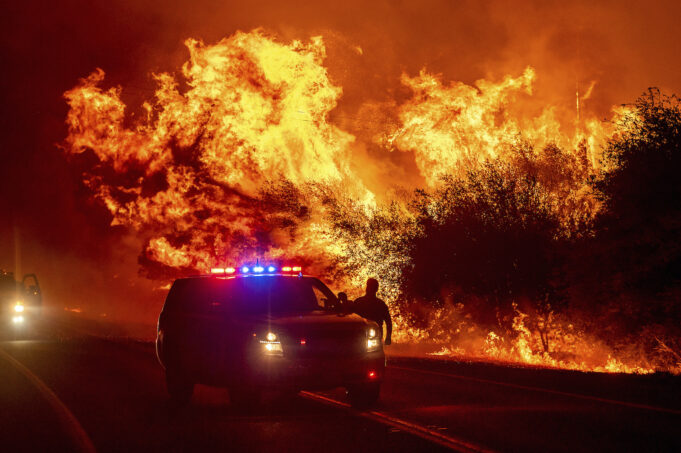BEAVERCREEK, Ore.—Nearly all the dozens of people reported missing after a devastating blaze in southern Oregon have been accounted for, authorities said as crews battled wildfires that have killed at least 35 from California to Washington state.
The flames up and down the West Coast have destroyed neighborhoods, leaving nothing but charred rubble and burned-out cars, forced tens of thousands to flee and cast a shroud of smoke that has given Seattle, San Francisco and Portland, Oregon, some of the worst air quality in the world. A record amount of California is burning, spurred by a nearly 20-year mega-drought. To the North, parts of Oregon that don’t usually catch fire are in flames. In Colorado a month-old northern Colorado wildfire has destroyed 25 residential buildings and a total of 54 structures, the Larimer County Sheriff’s Office reported. At least 2,000 people were under mandatory or voluntary evacuations orders because of the fire before a cold weather system moved into Colorado in early September. The fires consuming the forests of California and Oregon and darkening the skies over San Francisco and Portland are also damaging a regional economy already singed by the coronavirus outbreak. Wildfires are destroying property, running up huge losses for property insurers and putting a strain on economic activity along the West Coast that could linger for a year or more.
Meanwhile at presstime the Atlantic’s 16th and 17th named tropical storms were swirling, a record number for this time of year. Hurricane Sally, one of five storms lined up as if on a conveyor belt across the Atlantic, churned toward the Louisiana-Mississippi coast Sept. 14 with rapidly strengthening winds of at least 90 mph and the potential for as much as two feet of rain that could bring severe flooding.
In August it hit 130 degrees in Death Valley, the hottest Earth has been in nearly a century. Phoenix keeps setting triple-digit heat records, while Colorado went through a weather whiplash of 90-degree heat to snow in early Sept.
Amid all that, Iowa’s derecho—bizarre straight-line winds that got as powerful as a major hurricane, causing billions of dollars in damages—barely went noticed.
Freak natural disasters—most with what scientists say likely have a climate change connection—seem to be everywhere in the crazy year 2020. But experts say we’ll probably look back and say those were the good old days, when disasters weren’t so wild.
“It’s going to get A LOT worse,” Georgia Tech climate scientist Kim Cobb said Sept. 9. “I say that with emphasis because it does challenge the imagination. And that’s the scary thing to know as a climate scientist in 2020.”
Summer came to an abrupt halt in parts of the Rocky Mountains on Sept. 9 as temperatures reaching into the 90s plunged about 60 degrees in less than 24 hours, with a powerful surge of cold air from Canada unleashing snow and damaging winds in several states.
The roller coaster weather ripped up trees by their roots, piled up snow that shut down parts of the scenic road through Glacier National Park and knocked out power to tens of thousands. But the temperature drop is helping with wildfires in Colorado and Montana that had ballooned in hot, windy weather and forced people to flee their homes.
Heat and strong winds also hit California and parts of the Pacific Northwest over Labor Day weekend, igniting destructive wildfires.
Snow fell in Colorado, Montana and Wyoming. Far from the ocean and its moderating effect on weather, Colorado is no stranger to extreme shifts. However, Denver’s temperature drop, from 93 on Sept. 7 to 32 on Sept. 8, is “much earlier than we usually get this,” state climatologist Russ Schumacher said.
In Utah, where temperatures plummeted by 40 degrees, wind gusts of nearly 100 mph roared through Salt Lake City, downing trees and canceling the first day of online school. Officials warned people to stay inside to avoid flying debris, downed power lines and other dangers. Several semitrailer trucks blew over on northern Utah highways. (Compiled from Associated Press reports.)













